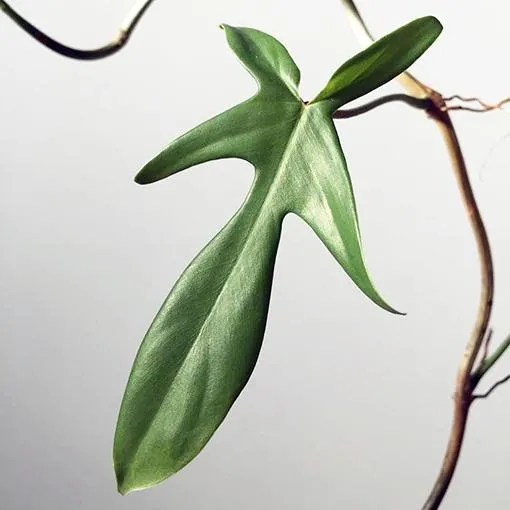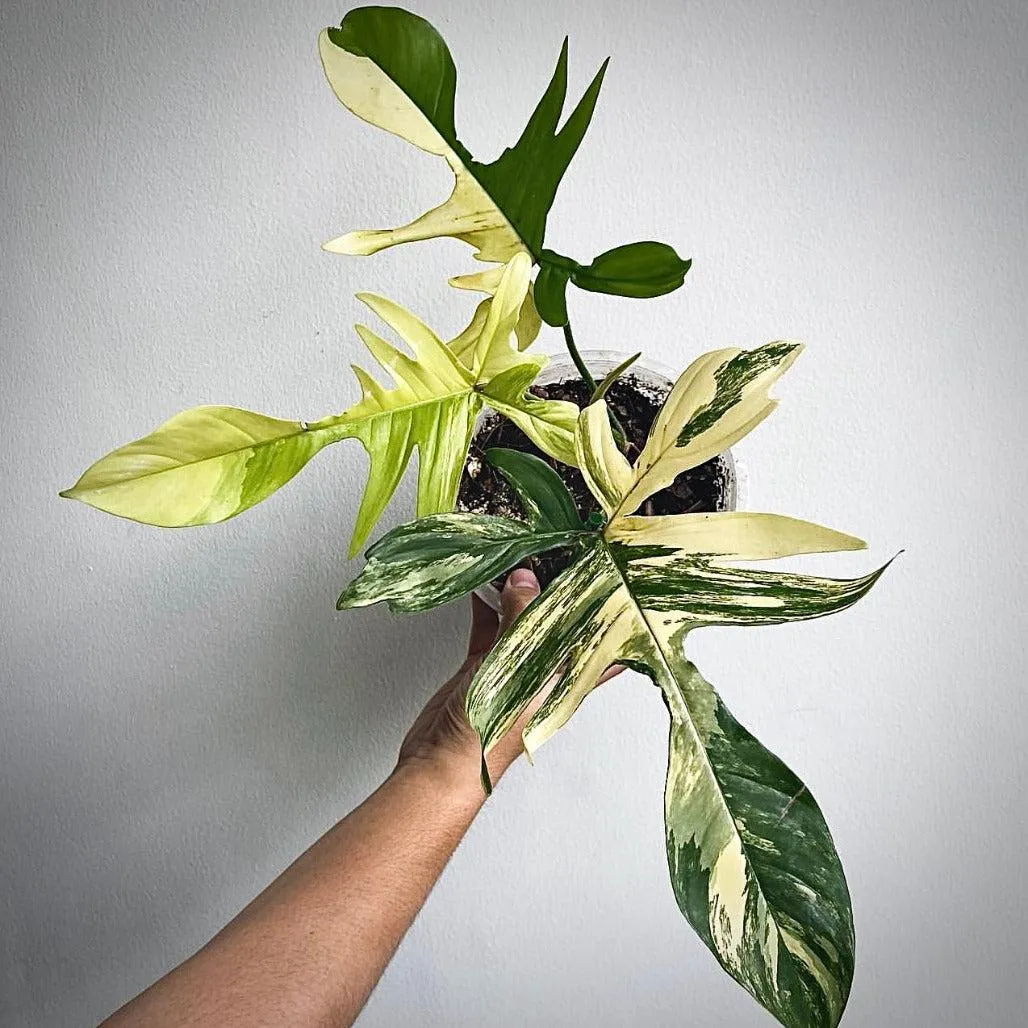Your Complete Guide to the Philodendron Florida Ghost Variegated
Has a philodendron with ghostly white splotches caught your eye? You may be interested in the philodendron florida ghost variegated. Let me tell you all about this unique philodendron variety and address any questions you may have.
What Exactly Is a Philodendron Florida Ghost Variegated?
- The philodendron florida ghost variegated is a cultivar (cultivated variety) of the common philodendron florida plant.
- It has heart-shaped green leaves splashed or splattered with ghostly white or cream-colored variegation.
- The white splotches appear almost like a pale paint splatter on the green leaf background, giving the plant a truly ghostly appearance.
From my experience growing various philodendron varieties, this one always stands out due to its unusual variegation pattern. The white marks look almost artificial – kind of like someone painted them on. But this is just the natural leaf coloring of this specialized cultivar.
Care Requirements of the Philodendron Florida Ghost
While philodendrons are known for being low maintenance houseplants, the florida ghost does have some special care needs due to its variegation:
- It needs bright, indirect light to prevent the white splotches from disappearing or fading out.
- Water when the top 2 inches of soil are dry and use a well-draining potting mix to avoid root rot from overwatering.
- It appreciates humidity levels around 50% to encourage vibrant variegation and healthy leaf growth.
- Fertilize monthly in the growing season with a dilute houseplant fertilizer.
The variegation can be temperamental unless conditions are just right. I’ve had issues with the white patches fading out or disappearing altogether if lightning and watering were inconsistent. It’s definitely one of the pickier philodendron varieties in my experience.
Variegation Stability and Reverting Concerns
A common issue plant owners ask me about is variegation stability in the philodendron florida ghost. The white splotches are prone to “reversion,” where new growth comes back predominantly or fully green instead of variegated.

There are a few reasons this happens:
- Genetics – Some varietals are simply less stable and more likely to revert.
- Care factors – Too much or too little light, water, or fertilizer can induce reversion.
- Age of plant – Younger specimens have heartier variegation versus older plants.
Basically, variegation fades with time unless you give optimal care. Taking cuttings to “propagate the variegation” is a popular strategy. You essentially clone the plant to retain its characteristic spotting indefinitely. It’s totally possible – I’ve nurtured Reverted cuttings back to their ghostly variegated selves on more than one occasion!
Suitable Growing Environments
While it thrives as a houseplant, the philodendron florida ghost can also live outdoors in USDA plant hardiness zones 10-11 with protection from direct sun. A covered patio or partial shade is generally best.
Indoors, this plant literally glows in a bright, eastern or western window. A screened porch gets abundant dappled light. You’ll also find it thriving in greenhouse settings like at botanic gardens.
Basically, as long as the variegated florida gets nice illumination without harsh direct rays, it’ll put on a gorgeous show wherever you keep it!

Pests and Diseases
Fortunately, these philodendrons are pretty pest-resistant as long as they’re healthy. You may still want to keep an eye out for:
- Spider mites – They love stressed, dry plants so avoid letting soil dry excessively.
- Mealybugs – Dab spots with alcohol or neem oil at the first sign.
- Root rot – Caused by overwatering so allow soil to dry between waterings.
Proper care practices will minimize issues. But no plant is invulnerable, so check regularly and isolate quickly if you spot pests invading your variegated beauty. A little prevention often pays off bigtime.
FAQs about the Philodendron Florida Ghost Variegated
To summarize and address any other concerns you might have:
- How fast does it grow? Moderate-to-fast growth rate, perfect for areas where you want a lusher tropical look.
- Does it flower? Rarely, only if conditions are exceptional. Focus on enjoying its beautiful foliage instead.
- Is it toxic to pets? Potentially irritating sap, so keep out of pets’ reach just in case.
- How long will it live? 5-10+ years as a houseplant with ongoing proper care.
- Any pest resistance? Moderately resistant, but check for occasional spider mites or other visitors.
In summary, the philodendron florida ghost variegated is a real stunner that brings irresistible tropical flair indoors or out. With the right spot and care attention, it’ll add gorgeous green-and-white accent foliage for years to come. Let me know if any other questions come up!
I hope this overview helped explain everything about this unique variegated plant variety. Feel free to reach out if you need any other info as you consider this bewitching beauty for your home or garden. Happy growing!

Philodendron florida ghost variegated care guide
| Detail | Specification |
|---|---|
| Light Requirements | Bright, indirect light. Avoid direct sun which can burn leaves. |
| Watering | Water when top inch of soil is dry. Do not overwater as it can cause root rot. |
| Humidity | Prefers humid conditions between 50-60%. Mist leaves to increase humidity around plant. |
| Soil | Well-draining potting mix. Does not like to sit in water. |
| Fertilizing | April-September, use diluted liquid houseplant fertilizer every 2 weeks. |
| Temperature | Average room temperature between 65-80°F. Avoid cold drafty areas. |
FAQ
-
What is a philodendron florida ghost variegated?
Basically, it’s a kind of wandering dude or philodendron plant with variegated leaves. The leaves have splotches of white or light green that makes them look kinda spooky, honestly.
-
How fast does it grow?
This plant can grow pretty fast depending on its conditions. If you give it lots of sunlight and keep the soil moist, it may put out a new leaf every week or two! They can climb very high if supported, but will also spread along the ground.
-
What care does it need?
A philodendron florida ghost needs bright, indirect light and average household temperatures around 70-80°F. Water when the top inch of soil dries out and feed monthly in the growing season. They’re considered pretty low maintenance overall. However, you gotta watch the humidity levels – it apparently hates being in a super dry environment.
-
Does it need support to climb?
You betcha – this guy will climb like crazy if you give him something to grasp onto. Poles, stakes, pieces of bark, tree branches – it doesn’t matter. He’ll scale right on up. Just be sure the support is sturdy enough so he doesn’t accidentally pull it over! On the other hand, it’ll also spread along the ground if you don’t provide anything vertical.
-
Are the leaves toxic to pets?
Most sources say philodendron leaves are mildly toxic to pets if they eat large quantities. However, a couple leaves shouldn’t cause significant issues. Keeping it out of reach is probably a good idea just to be safe. You never know with some cats and dogs! It may not be worth the risk of an expensive vet bill.

-
How much does a variegated plant usually cost?
Retail prices seem to range from around $15-30 usually, depending on the plant’s size and leaf variegation pattern. Sometimes you can find smaller 4″ pots for closer to $10-15. However, big full plants commanding superior prices of $50 or more are not unheard of. As with anything, buying locally or in-season will give you a better deal versus shipping from far away. You never know until you look, I guess!
-
What arrangements has it been seen in?
Botanists have observed specimens of philodendron florida ghost variegated climbing trees in Florida hammocks, perhaps seeking that crucial sunlight. However, it also looks wonderful in hanging baskets, on plant stands, trailing from shelves, or in a variety of indoor landscapes. Get creative! Just keep an eye out for mosquitoes if displayed near standing water, as those Florida varieties apparently attract them. You’ve been warned!
